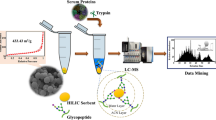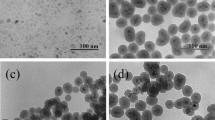Abstract
Immobilization of enzymes on mesoporous microparticulate carriers has traditionally been accompanied by reduction in enzyme activity. Herein, we document that immobilization of pepsin via amide coupling on gold nanoparticles (GNPs) with a carboxy-terminated hydrophilic PEG7 shell resulted in a heterogeneous nanobiocatalyst with essentially equivalent turnover rates, k cat (90 %), and enhanced catalytic efficiencies, k cat/K M (107 %), compared to homogeneous catalysis with pepsin in free solution for cytochrome C as model substrate. This heterogeneous catalyst showed further at least equivalent bioactivity in a digestion reaction of a protein mixture consisting of cytochrome C, bovine serum albumin, and myoglobin. UHPLC–ESI-QTOF-MS/MS analysis of the digests with subsequent Mascot database search allowed unequivocal identification of all proteins with high score and good sequence coverage. The functionalized nanoparticles were further characterized by Vis spectroscopy in terms of the surface plasmon resonance (SPR) band, by dynamic light scattering (DLS) with regard to hydrodynamic diameters, and in view of their ζ potentials at each step of synthesis and surface modification. These measurements also revealed that the pepsin-functionalized GNPs were sufficiently stable over at least 1 month; thus providing a satisfactory shelf life to the heterogeneous catalyst. Advantageously, the pepsin–GNP bioconjugate can be conveniently removed after reaction by simple centrifugation steps which makes them a useful tool for analysis of therapeutic peptides and proteins, including monoclonal antibodies. The practical utility of the nanobiocatalyst was documented by digestion of a monoclonal antibody which yielded the F(ab')2 fragment with a mass of 97,619.4 Da.

Pepsin conjugated to pegylated gold nanoparticles exhibit properties of homogeneous catalysis such as enzyme activity like pepsin in solution and ability to pipette the stable colloidal suspension whereas one can take benefit from easy removal by centrifugation and re-use which are characteristics of heterogeneous catalysis.








Similar content being viewed by others
References
Tsiatsiani L, Heck AJR. Proteomics beyond trypsin. FEBS J. 2015;282(14):2612–26. doi:10.1111/febs.13287.
Beck A, Wagner-Rousset E, Ayoub D, Van Dorsselaer A, Sanglier-Cianferani S. Characterization of therapeutic antibodies and related products. Anal Chem. 2013;85(2):715–36. doi:10.1021/ac3032355.
Gerhardt H, Sievers-Engler A, Jahanshah G, Pataj Z, Ianni F, Gross H, et al. Methods for the comprehensive structural elucidation of constitution and stereochemistry of lipopeptides. J Chromatogr A. 2016;1428:280–91. doi:10.1016/j.chroma.2015.05.065.
Safdar M, Spross J, Janis J. Microscale immobilized enzyme reactors in proteomics: latest developments. J Chromatogr A. 2014;1324:1–10. doi:10.1016/j.chroma.2013.11.045.
Zhanga Y, Gea J, Zheng L. Enhanced activity of immobilized or chemically modified enzymes. ACS Catal. 2015;5(8):4503–13. doi:10.1021/acscatal.5b00996.
Liu J, Yang Q, Li C. Towards efficient chemical synthesis via engineering enzyme catalysis in biomimetic nanoreactors. Chem Commun. 2015;51(72):13731–9. doi:10.1039/C5CC04590H.
Misson M, Zhang H, Jin B. Nanobiocatalyst advancements and bioprocessing applications. J R Soc Interface. 2015;12(102):1–20. doi:10.1098/rsif.2014.0891.
Vaghari H, Jafarizadeh-Malmiri H, Mohammadlou M, Berenjian A, Anarjan N, Jafari N, et al. Application of magnetic nanoparticles in smart enzyme immobilization. Biotechnol Lett. 2015. doi:10.1007/s10529-015-1977-z.
Johnson BJ, Russ Algar W, Malanoski AP, Ancona MG, Medintz IL. Understanding enzymatic acceleration at nanoparticle interfaces: approaches and challenges. Nano Today. 2014;9(1):102–31. doi:10.1016/j.nantod.2014.02.005.
Ding S, Cargill AA, Medintz IL, Claussen JC. Increasing the activity of immobilized enzymes with nanoparticle conjugation. Curr Opin Biotechnol. 2015;34:242–50. doi:10.1016/j.copbio.2015.04.005.
Roco MC, Williams RS, Alivisatos P, editors. Nanotechnology research directions: IWGN workshop report; vision for nanotechnology R&D in the next decade. Washington DC: US National Science and Technology Council; 2000.
Hinterwirth H, Lindner W, Laemmerhofer M. Bioconjugation of trypsin onto gold nanoparticles: effect of surface chemistry on bioactivity. Anal Chim Acta. 2012;733:90–7. doi:10.1016/j.aca.2012.04.036.
Homaei A, Barkheh H, Sariri R, Stevanato R. Immobilized papain on gold nanorods as heterogeneous biocatalysts. Amino Acids. 2014. doi:10.1007/s00726-014-1724-0.
Bolivar JM, Eisl I, Nidetzky B. Advanced characterization of immobilized enzymes as heterogeneous biocatalysts. Catal Today. 2015. doi:10.1016/j.cattod.2015.05.004.
Polte J, Ahner TT, Delissen F, Sokolov S, Emmerling F, Thunemann AF, et al. Mechanism of gold nanoparticle formation in the classical citrate synthesis method derived from coupled in situ XANES and SAXS evaluation. J Am Chem Soc. 2010;132(4):1296–301. doi:10.1021/ja906506j.
Turkevich J, Stevenson PC, Hillier J. The nucleation and growth processes in the synthesis of colloidal gold. Discuss Faraday Soc. 1951;11:55–75. doi:10.1039/df9511100055.
Frens G. Controlled nucleation for the regulation of the particle size in monodisperse gold suspensions. Nature Phys Sci. 1973;241:20–2.
Ojea-Jimenez I, Romero FM, Bastus NG, Puntes V. Small gold nanoparticles synthesized with sodium citrate and heavy water: insights into the reaction mechanism. J Phys Chem C. 2010;114(4):1800–4. doi:10.1021/jp9091305.
Kumar S, Gandhi KS, Kumar R. Modeling of formation of gold nanoparticles by citrate method. Ind Eng Chem Res. 2007;46(10):3128–36. doi:10.1021/ie060672j.
Haiss W, Thanh NTK, Aveyard J, Fernig DG. Determination of size and concentration of gold nanoparticles from UV-Vis spectra. Anal Chem. 2007;79:4215–21. doi:10.1021/ac0702084.
Hendel T, Wuithschick M, Kettemann F, Birnbaum A, Rademann K, Polte J. In situ determination of colloidal gold concentrations with UV-Vis spectroscopy: limitations and perspectives. Anal Chem. 2014;86(22):11115–24. doi:10.1021/ac502053s.
Lin S-Y, Tsai Y-T, Chen C-C, Lin C-M, Chen C-H. Two-step functionalization of neutral and positively charged thiols onto citrate-stabilized Au nanoparticles. J Phys Chem B. 2004;108(7):2134–9. doi:10.1021/jp036310w.
Hermanson GT, editor. Bioconjugate techniques. Amsterdam: Academic; 1995.
Cao Y, Wen L, Svec F, Tan T, Lv Y. Magnetic AuNP@Fe3O4 nanoparticles as reusable carriers for reversible enzyme immobilization. Chem Eng J. 2016;286:272–81. doi:10.1016/j.cej.2015.10.075.
Nidhin M, Ghosh D, Yadav H, Yadav N, Majumder S. Structural and functional aspects of trypsin-gold nanoparticle interactions: an experimental investigation. Mater Sci Eng B. 2015;202:46–53. doi:10.1016/j.mseb.2015.09.006.
Willner I, Baron R, Willner B. Integrated nanoparticle-biomolecule systems for biosensing and bioelectronics. Biosens Bioelectron. 2007;22(9-10):1841–52. doi:10.1016/j.bios.2006.09.018.
Ang SH, Yu CY, Ang GY, Chan YY, Yb A, Khor SM. A colloidal gold-based lateral flow immunoassay for direct determination of haemoglobin A1c in whole blood. Anal Methods. 2015;7(9):3972–80. doi:10.1039/C5AY00518C.
Niu K, Zheng X, Huang C, Xu K, Zhi Y, Shen H, et al. A colloidal gold nanoparticle-based immunochromatographic test strip for rapid and convenient detection of Staphylococcus aureus. J Nanosci Nanotechnol. 2014;14(7):5151–6. doi:10.1166/jnn.2014.8703.
Qian X, Peng X-H, Ansari DO, Yin-Goen Q, Chen GZ, Shin DM, et al. In vivo tumor targeting and spectroscopic detection with surface-enhanced Raman nanoparticle tags. Nat Biotechnol. 2008;26(1):83–90. doi:10.1038/nbt1377.
Florkin M. Discovery of pepsin by Theodor Schwann. Rev Med Liege. 1957;12(5):139–44.
Northrop JH. Crystalline pepsin. Science. 1929;69(1796):580.
Schmelzer CEH, Schoeps R, Ulbrich-Hofmann R, Neubert RHH, Raith K. Mass spectrometric characterization of peptides derived by peptic cleavage of bovine β-casein. J Chromatogr A. 2004;1055(1-2):87–92. doi:10.1016/j.chroma.2004.09.003.
Goldstein J, Konigsberg W, Hill RJ. The structure of human hemoglobin. VII, The digestion of the β chain of human hemoglobin with pepsin. J Biol Chem. 1963;238:2028–33.
Huckel M, Wirth H-J, Hearn MTW. Porous zirconia: a new support material for enzyme immobilization. J Biochem Biophys Methods. 1996;31(3,4):165–79. doi:10.1016/0165-022X(95)00035-P.
Ahn J, Jung MC, Wyndham K, Yu YQ, Engen JR. Pepsin immobilized on high-strength hybrid particles for continuous flow online digestion at 10 000 psi. Anal Chem. 2012;84(16):7256–62. doi:10.1021/ac301749h.
Bandhu A, Sutradhar S, Mukherjee S, Greneche JM, Chakrabarti PK. Synthesis, characterization and magnetic property of maghemite (γ-Fe2O3) nanoparticles and their protective coating with pepsin for bio-functionalization. Mater Res Bull. 2015;70:145–54. doi:10.1016/j.materresbull.2015.04.035.
Han W, Yamauchi M, Hasegawa U, Noda M, Fukui K, van der Vlies AJ, et al. Pepsin immobilization on an aldehyde-modified polymethacrylate monolith and its application for protein analysis. J Biosci Bioeng. 2015;119(5):505–10. doi:10.1016/j.jbiosc.2014.10.018.
Geiser L, Eeltink S, Svec F, Frechet JMJ. In-line system containing porous polymer monoliths for protein digestion with immobilized pepsin, peptide preconcentration and nano-liquid chromatography separation coupled to electrospray ionization mass spectroscopy. J Chromatogr A. 2008;1188(2):88–96. doi:10.1016/j.chroma.2008.02.075.
Long Y, Wood TD. Immobilized pepsin microreactor for rapid peptide mapping with nanoelectrospray ionization mass spectrometry. J Am Soc Mass Spectrom. 2015;26(1):194–7. doi:10.1007/s13361-014-1015-8.
Meridor D, Gedanken A. Enhanced activity of immobilized pepsin nanoparticles coated on solid substrates compared to free pepsin. Enzym Microb Technol. 2014;67:67–76. doi:10.1016/j.enzmictec.2014.09.004.
Stigter ECA, de Jong GJ, van Bennekom WP. Pepsin immobilized in dextran-modified fused-silica capillaries for on-line protein digestion and peptide mapping. Anal Chim Acta. 2008;619(2):231–8. doi:10.1016/j.aca.2008.04.060.
Innocent C, Bouhaine N, Djerourou A, Gherrou A, Seta P, Xu ZK. Preparation of catalytic materials by covalent immobilisation of pepsin on cotton fibers activated by tosyl chloride. Mater Sci Indian J. 2006;2(6):161–8.
Li J, Wang J, Gavalas VG, Atwood DA, Bachas LG. Alumina-pepsin hybrid nanoparticles with orientation-specific enzyme coupling. Nano Lett. 2003;3(1):55–8. doi:10.1021/nl025778s.
Sharma B, Mandani S, Sarma TK. Catalytic activity of various pepsin reduced Au nanostructures towards reduction of nitroarenes and resazurin. J Nanopart Res. 2015;17(1):1–12. doi:10.1007/s11051-014-2835-y.
Gole A, Dash C, Ramakrishnan V, Sainkar SR, Mandale AB, Rao M, et al. Pepsin-gold colloid conjugates: preparation, characterization, and enzymatic activity. Langmuir. 2001;17(5):1674–9. doi:10.1021/la001164w.
Haller E, Lindner W, Laemmerhofer M. Gold nanoparticle-antibody conjugates for specific extraction and subsequent analysis by liquid chromatography-tandem mass spectrometry of malondialdehyde-modified low density lipoprotein as biomarker for cardiovascular risk. Anal Chim Acta. 2015;857:53–63. doi:10.1016/j.aca.2014.12.024.
Hinterwirth H, Wiedmer SK, Moilanen M, Lehner A, Allmaier G, Waitz T, et al. Comparative method evaluation for size and size-distribution analysis of gold nanoparticles. J Sep Sci. 2013;36(17):2952–61. doi:10.1002/jssc.201300460.
Lineweaver H, Burk D. Determination of enzyme dissociation constants. J Am Chem Soc. 1934;56:658–66. doi:10.1021/ja01318a036.
Lowry OH, Rosebrough NJ, Farr AL, Randall RJ. Protein measurement with the Folin phenol reagent. J Biol Chem. 1951;193(1):265–75.
Hinterwirth H, Kappel S, Waitz T, Prohaska T, Lindner W, Laemmerhofer M. Quantifying thiol ligand density of self-assembled monolayers on gold nanoparticles by inductively coupled plasma-mass spectrometry. ACS Nano. 2013;7:1129–36. doi:10.1021/nn306024a.
Mie G. Contributions to the optics of turbid media, especially colloidal metal solutions. Ann Phys. 1908;25:377–445.
Malola S, Lehtovaara L, Enkovaara J, Häkkinen H. Birth of the localized surface plasmon resonance in monolayer-protected gold nanoclusters. ACS Nano. 2013;7(11):10263–70. doi:10.1021/nn4046634.
Greenwell P, Knowles JR, Sharp H. Inhibition of pepsin-catalyzed reactions by products and product analogs. Kinetic evidence for ordered release of products. Biochem J. 1969;113(2):363–8. doi:10.1042/bj1130363.
Oliveros JC (2007) Venny. An interactive tool for comparing lists with Venn's diagrams. http://bioinfogp.cnb.csic.es/tools/venny/index.html.
Koenig T, Menze BH, Kirchner M, Monigatti F, Parker KC, Patterson T, et al. Robust prediction of the MASCOT score for an improved quality assessment in mass spectrometric proteomics. J Proteome Res. 2008;7:3708–17. doi:10.1021/pr700859x.
Perkins DN, Pappin DJC, Creasy DM, Cottrell JS. Probability-based protein identification by searching sequence databases using mass spectrometry data. Electrophoresis. 1999;20:3551–67. doi:10.1002/(sici)1522-2683(19991201)20:18<3551::aid-elps3551>3.0.co;2-2.
Acknowledgements
We acknowledge support by the Struktur- und Innovationsfonds Baden-Württemberg (SI-BW) and the German Science Funds (DFG no. INST 37/821-1 FUGG). We are grateful to Prof. Rolf Daniels for providing access to the Zetasizer Nano instrument for DLS and ζ potential measurements.
Author information
Authors and Affiliations
Corresponding author
Ethics declarations
Conflict of interest
The authors declare no competing conflict of interest.
Additional information
ABC Highlights: authored by Rising Stars and Top Experts.
Electronic supplementary material
Below is the link to the electronic supplementary material.
ESM 1
(PDF 1796 kb)
Rights and permissions
About this article
Cite this article
Höldrich, M., Sievers-Engler, A. & Lämmerhofer, M. Gold nanoparticle-conjugated pepsin for efficient solution-like heterogeneous biocatalysis in analytical sample preparation protocols. Anal Bioanal Chem 408, 5415–5427 (2016). https://doi.org/10.1007/s00216-016-9657-y
Received:
Revised:
Accepted:
Published:
Issue Date:
DOI: https://doi.org/10.1007/s00216-016-9657-y




